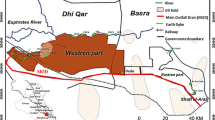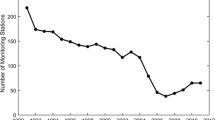Abstract
Design and redesign of water quality monitoring networks were evaluated for two similarly sized watersheds in the tropical Andes via optimization techniques using geographic information system technology (GIS) and a matter-element analysis of 5-day biological oxygen demand (BOD5) and total suspended solids (TSS). This resulted in a flexible, objectively based design for a 1128-km2 watershed without prior water quality data (La Miel River), and a network redesign of a 1052-km2 watershed with historical water quality monitoring (Chinchiná River). Monitoring design for the undocumented basin incorporated mathematical expressions for physical, anthropological, and historical factors—and was based on clear objectives for diagnosis and intervention of water pollution. Network redesign identified network redundancy, which resulted in a 64% reduction in the number of water quality monitoring stations along the channel, and a 78% reduction of stations throughout the basin. Most tropical drainage basins throughout the world have little to no prior water quality data. But even in well-studied drainage basins like the Chinchiná River, which is among the most thoroughly studied basins in Colombia, redesign of historical and existing monitoring networks will become a standard tool to advance the restoration of polluted surface waters, not only in Colombia, but also throughout the world.











Similar content being viewed by others
References
Asadollahfardi G, Asadi M, Nasrinasrabadi M, Faraji A (2014) Dynamic programming approach (DPA) for assessment of water quality network: a case study of the Sefīd-Rūd River. Water Practice & Technology 9(2):135
Bastidas JC (2015) Development of a methodology for the optimal design of water quality monitoring networks in surface water sources. Master Thesis. Universidad Nacional de Colombia Sede Manizales. 174pp. (In Spanish)
Bastidas JC, Vélez JJ, Zambrano J (2016) Approach for the optimal design of water quality monitoring networks in tropical Andean basins. In Proceedings: 2nd EWaS International Conference. Efficient & Sustainable Water System Management toward Worth Living Development. June 2016, Chania, Crete, Greece. 1–10
Cano L, Escobar J (2011) Design of monitoring networks supported by GIS tools and geospatial modeling. Aqua-LAC 3(1):18–25 (In Spanish)
Carvajal LF (2013) A management model of the quality and quantity of water with gray diffuse logic for the river Aburrá. Revista Ingeniería Universidad de Medellín 12(22):59–74 (In Spanish)
Chen Q, Wu W, Blanckaert K, Ma J, Huang G (2012) Optimization of water quality monitoring network in a large river by combining measurements, a numerical model and matter-element analyses. J Environ Manag 110:116–124
CORPOCALDAS (2007) Regional Environmental Management Plan 2007–2019 (No. 1). Technical report. Corporación Regional Ambiental de Caldas. Manizales. http://www.corpocaldas.gov.co/publicaciones/329/PGAR%20%202007-2019_Completo.pdf Accessed: 11 November 2016 (In Spanish)
CORPOCALDAS-Idea (2004) Regional Environmental Management Plan La Miel. Technical report, Instituto de Estudios Ambientales IDEA, UNAL Sede Manizales 532–583 (In Spanish)
CORPOCALDAS-Unal (2015) Plan for management and environmental management of the Chinchiná River Basin, Chapter 4. Technical report. Universidad Nacional de Colombia Sede Manizales. 55p (In Spanish)
Dannisøe J, Larsen H (1997) The use of models in monitoring strategies. In Proceedings: monitoring tailor-made II. Information strategies in water management. September, Nunspeet, The Netherlands, 247–252
Erazo DE, Londoño A, Aristizabal BH (2015) Study of the impact of volcanic fluids in the water resource of Chinchiná watershed. Gestion y Ambiente 18(2):81–93
Harmancioglu N, Alpaslan N (1992) Water quality monitoring network design: a problem of multi-objective decision making. Water Resources Bulletin AWRA 28(1):179–192
IDEAM (2003) Guide for the monitoring of pollutant loads, surface water and groundwater. Technical report. Instituto de Hidrología, Meteorología y Estudios Ambientales de Colombia - IDEAM, Bogotá 83p (In Spanish)
IDEAM (2010) National water study. Technical report, Instituto de Hidrología, Meteorología y Estudios Ambientales de Colombia—IDEAM, Bogotá 420p (In Spanish)
Junior A, Da Silva G, Neves B, Davens J (2005) Métodos directos de determinacao do coeficiente de dispesao longitudinal em cursos de agua naturais. Parte I. Fundamentos teóricos. Revista Escola de Minas Ouro Preto 58(1):27–32
Karamouz M, Karami M, Kerachian R (2004) Design of water quality network for river systems. In proceedings: World Water Congress. ASCE 12 p
Karamouz M, Kerachian R, Akhbari M et al (2009) Design of river water quality monitoring networks: a case study. Environ Model Assess 14:705. doi:10.1007/s10666-008-9172-4
Lee C, Paik K, Yoo DG, Kim JH (2014) Efficient method for optimal placing of water quality monitoring stations for an ungauged basin. J Environ Manag 132(1):24–31
MADS (2014) Technical guide for the formulation of water resource management plans. Ministry of Environment and Sustainable Development, Bogotá 151 pp (In Spanish)
Moreno A, Toro M, Carvajal L (2008) Review of criteria and methodologies for the design of networks for the monitoring of water quality in rivers. Avances en Recursos Hidráulicos 18(1):57–68 (In Spanish)
Ning S, Chang N (2002) Multi-objective, decision-based assessment of a water quality monitoring network in a river system. J Environ Monit 4:121–126
Park S, Choi J, Wang S (2006) Design of water quality network in a large river system using genetic algorithm. Ecol Model 199(1):289–297
PROAGUA-Corpocaldas (2013) Characterization and evaluation of the water quality of the Chinchiná River Technical report. Manizales. 161 p (In Spanish)
Ruiz R, Ferreira M, Schmidt A (2006) Stochastic search algorithms for optimal monitoring network designs. Instituto de Matemática, Universidad Federal Do Rio Do Janeiro, Brasil, p 19
Sanders T, Adrian D, Berger B. (1976). Design of a river basin sampling system. Water Resources Research Center. University of Massachusetts at Amherst. Publication N°62. Report FY-76-9. 88p
Segura S, Vargas V, Galvis A. (2003) Metodología geoestadística para proponer estaciones de muestreo en el río Cacua en el tramo Salvajina – La Virginia. In Proceedings: International Conference: Hidroinformatica en la gestión integrada de los recursos hídricos. Universidad del Valle CINARA. 142–150
Smith M (1994) New Zealand’s national river water quality network. 1. Design and physic-chemical characterization. N Z J Mar Freshw Res 28(1):19–35
Smyth GK, Dixon W, Chiswell B (1999) Optimized selection of river sampling sites. Water Res 33(4):971–987
Strobl RO, Robillard PD (2008) Network design for water quality monitoring of surface freshwaters: a review. J Environ Manag 87(4):639–648
Telci IT, Nam K, Guan J, Aral MM (2009) Optimal water quality monitoring network design for river systems. J Environ Manag 90(10):2987–2998
Zhang JM, Lu SB, Li HE (2010) Application of matter-element theory in assessment of regional water resources, in proceedings: environmental science and information application technology (ESIAT). Wuhan 2010:4–7. doi:10.1109/ESIAT.2010.5568947
Acknowledgements
The authors would like to thank CORPOCALDAS, who supplied data and funded the Project “Linea Base Ambiental de Caldas” which supplied some support for this paper, and special thanks to IDEA and “GTA Ingeniería Hidráulica y Ambiental” of Universidad Nacional de Colombia Sede Manizales.
Author information
Authors and Affiliations
Corresponding author
Additional information
Responsible editor: Kenneth Mei Yee Leung
Rights and permissions
About this article
Cite this article
Bastidas, J.C., Vélez, J.J., Zambrano, J. et al. Design of water quality monitoring networks with two information scenarios in tropical Andean basins. Environ Sci Pollut Res 24, 20134–20148 (2017). https://doi.org/10.1007/s11356-017-9021-6
Received:
Accepted:
Published:
Issue Date:
DOI: https://doi.org/10.1007/s11356-017-9021-6




